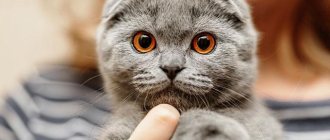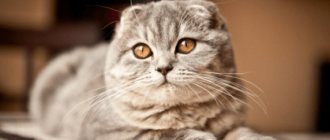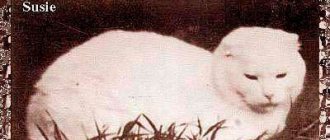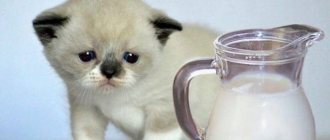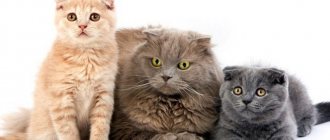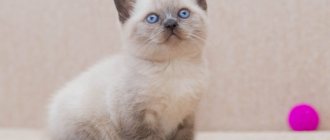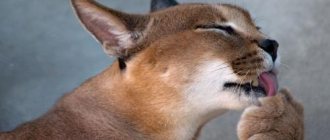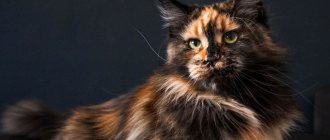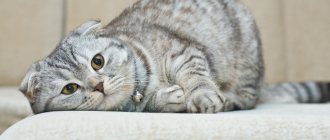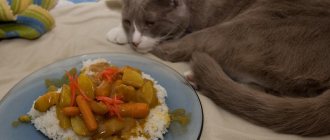There is an opinion that the Scottish Fold cat is extremely susceptible to all kinds of diseases and health problems in general. Diseases just stick to the poor animal. Poor unbalanced diet, lack of physical activity, improper care - all these factors only contribute to an increase in morbidity among representatives of the species.
Owners should know in advance what diseases and why are most common in Scottish Folds, how to reduce the risk of their occurrence, and, if necessary, provide first aid.
I will tell you all about this in the article.
Scottish Fold health and causes of disease
Owners of Scottish Fold cats often complain about their pets’ poor health and abnormal skeletal development. Often animals do not even survive to 5 years of age. The reason is a genetic predisposition to pathologies.
Breed diseases typical of Scottish fold cats are caused by the presence of a mutant fold gene in the body.
It is dominant, that is, it always appears in the litter when mating individuals wearing it. The problem is that this gene causes not only the formation of funny ears, but also abnormal development of the skeleton and vestibular system.
A gene mutation leads to weakness and shortening of bones, fusion of vertebrae in a fold-eared animal. The cat has problems with motor activity, and its gait becomes unnatural. But such anomalies are inevitable only if the kitten is born from both fold-eared parents.
If one of the parents is straight-eared, then the cubs are usually born healthy; abnormal skeletal development in the litter is extremely rare. And such cats live longer, their age can exceed 12 years.
But crossing representatives of straight and fold varieties does not provide 100% protection against genetic abnormalities. Although much less common, Scottish Straight cats can also develop:
- pathologies of bones and joints - osteochondrodysplasia, osteochondrodystrophy, arthritis, arthrosis;
- abnormal structure of the ear canals;
- deformation of the eyelids;
- cardiomyopathy;
- disorders of the digestive tract;
- pathologies of the urinary system;
- infectious diseases.
IMPORTANT! To reduce the likelihood of breed-related diseases in offspring, fold-eared individuals should be mated exclusively with straight-eared ones.
Trauma is the most common cause of lameness in cats.
Cats are by nature very active and curious. These qualities often play a cruel joke on them. While examining unfamiliar objects, they can receive various injuries: open injuries to the skin and soft tissues, dislocations, sprains and torn ligaments, bone fractures and joint injuries. If your four-legged pet suddenly becomes lame, the cause of the lameness probably lies in one of the listed problems.
Soft tissue damage
Fights with relatives and contact with sharp objects can lead to damage to soft tissues. This condition, in addition to lameness, is accompanied by bleeding of varying degrees of intensity, redness of surrounding tissues, and acute pain. Traumatic swelling often occurs, which over time turns into purulent inflammation. The appearance of pus poses the greatest danger.
If the wound is deep and extensive, surgery is required. Injuries received within a few hours before contacting a veterinarian are disinfected and closed with a blind suture. If more time has passed since the injury or there are signs of wound infection, treatment includes the use of antibacterial, anti-inflammatory and analgesic veterinary medications.
If you notice that your pet is pressing its front or back paw, you need to examine it. If there is a wound, it should be treated with any available antiseptic and try to stop the bleeding yourself, and then take the animal to the veterinary clinic.
Dislocations, sprains and ligament tears
Cats group well when jumping, trying to land on their paws. However, they are not always able to group correctly, and if the landing is unsuccessful, dislocation or damage to the ligaments is possible. These are rare injuries for felines, but their possibility cannot be completely ruled out. Information about them is presented in the table:
| Type of limb injury | Symptoms | First aid | Treatment | |
| Dislocation | Loss of support ability of the affected paw, swelling, asymmetry and deformation of the contours of the damaged joint | Immobilize the affected limb, apply ice for 10–15 minutes, temporarily stop feeding | Closed or open reduction and fixation using immobilizing bandages or splints. | |
| Ligament damage | Stretching | Lameness, shooting pain, in which the animal squints and twitches, trying to lean on the sore paw, the “drawer” effect (the joint is loose, the bones “play”) | Immobilization of the injured limb | Surgical repair of a damaged ligament. |
| Gap |
Bone fractures and joint injuries
Signs of injury:
- lameness;
- violation of skin integrity and bleeding (with an open fracture);
- pain;
- change in the natural position of the damaged paw;
- crunch when palpated.
Before transporting your pet to the veterinary clinic, you must:
- remove dirt and bone fragments from the wound and stop bleeding by pressing a finger wrapped in a clean napkin to the wound;
- disinfect the affected area;
- immobilize the injured limb by placing a board or wide ruler on it and securing a homemade splint with a bandage, belt or belt.
The cat must be transported to the veterinary clinic while lying down, placing it on a hard, flat surface. Closed and uncomplicated fractures are treated conservatively, complex injuries are treated surgically.
Genetic diseases
Scottish Fold cats are characterized by two genetic pathologies:
- osteochondrodystrophy;
- hemophilia B-type.
Osteochondrodystrophy will be discussed in detail below, and hemophilia B is a terrible consequence of the transmission of a mutant gene. The Scottish Fold cat has low blood clotting, which threatens heavy bleeding during wound formation or surgery.
Due to the lack of fibrin in the blood, the wound is not covered with a crust that blocks bleeding. The cat dies from blood loss.
Osteochondrodystrophy
The pathology is accompanied by deformation and inflammation of the joints. A sick cat cannot jump, its movements are constrained and unnatural. The limbs are shortened, bend poorly, and lameness is noticeable.
The structure of the skeleton is abnormal: the skull is large, the jaw is curved, the tail vertebrae are too thick, which is why the mobility of the tail is reduced.
A skeletal abnormality results from improper development of cartilage tissue. The vertebral and peripheral bones are deformed, the kitten hardly grows, the distance between its stomach and the floor remains small. That is, the animal becomes a dwarf.
The owner may not immediately notice pathological skeletal changes in the pet, since Scottish Fold cats have a small, compact body.
Some cats manage to redistribute the load from the diseased limb to the healthy ones for a long time, so lameness is not noticeable. But many fold-eared kittens begin limping within a few weeks of birth.
The disease cannot be cured; it ends in the death of the cat. To relieve pain, veterinarians prescribe non-steroidal anti-inflammatory drugs and chondroprotectors.
Osteochondrodysplasia
The genetic disease is osteochondrodysplasia of Scottish fold cats (OSF), a common, incurable disease that affects the bones and joints of the animal. Caused by the presence of an individual gene for “loop ears”, which is specific to the Scottish Fold and Highland Fold. Diseases of Scottish Fold cats appear in newborn kittens in the first months of life.
OCD, a hereditary disease, is transmitted regardless of the sex of the animal from offspring to parents. To protect animals from the transmission of heredity, mating within the Scottish Fold and Highland Fold species is prohibited; interspecific mating is allowed only within the Scottish breed with straight-eared cats - Scottish Straight, Highland Straight. If you follow the rules of crossing, the risk of developing DCD is greatly reduced.
When OCD manifests itself, bone tissue grows around the joints, and the bones and cartilage of the entire spine skeleton, starting with the tail, and limbs are affected.
It is impossible to cure a gene disease at the present stage; measures are being taken to stop the development of the disease.
Symptoms
The disease osteochondrodysplasia of Scottish cats appears already in the first months after the birth of a kitten, in rare cases in adulthood. And if at first it is little noticeable, then it quickly progresses with age
Main symptoms to look out for:
- Sharp decrease in activity:
- Movement is difficult, the kitten does not jump, moves little;
- The gait changes, lameness is observed.
- There are obvious changes in appearance:
- Underdeveloped, twisted limbs with shorter hind legs, all joints are twisted;
- Increased head volume with a protruding jaw and crooked teeth;
- The short, almost unbending tail is motionless and thin at the base.
- The pet constantly experiences pain, sometimes severe.
If these signs are present, contact specialists. There they will make a correct diagnosis and prescribe treatment.
https://youtube.com/watch?v=UNtiHVG0-vI%3F
Treatment
To the veterinary clinic, in order to make a correct diagnosis of the Scottish fold cat and prescribe treatment:
- They study the cat's pedigree and conduct an initial examination of the animal. To verify the signs of OCD and understand what to do in the future, the following is prescribed:
- x-ray of limbs and spine;
- carry out anamnesis collection, biochemical analysis of blood and urine;
- a bone tissue sample is taken.
- When the diagnosis of osteochondrodysplasia is confirmed, supportive therapy and treatment are prescribed to make life easier and reduce pain:
- anti-inflammatory drugs;
- intra-articular injections of chondroprotectors “Chondroitin sulfate”, “Chondroitin” and “Glucosamine”
- It is recommended to regularly do a special massage that will improve blood circulation in the extremities;
If therapeutic treatment does not bring relief, it is prescribed for arthrosis or osteotomy - a surgical operation.
Eye diseases
Due to the possible abnormal structure of the skull, the Scottish Fold may develop eye diseases. The skin is stretched over the large skull so that the eyelids turn inward or outward.
Eyelashes dig into the eyeball, vision gradually deteriorates. If you do not contact a veterinary surgeon in a timely manner, your cat may lose its vision.
Another problem associated with the abnormal structure of the skull is incomplete closure of the eyelids. The cat has tears and mucus flowing profusely from the eyes, and photophobia develops. It is urgent to take the animal to the veterinarian before the problem develops into cataracts or glaucoma.
Scottish kittens have a weak immune system, so conjunctivitis, caused by eye infection, is often observed. If the inflammation is not severe, it is enough to wash your eyes with chamomile infusion or weak tea leaves. If conjunctivitis is severe, the veterinarian will prescribe medicinal drops.
Glaucoma often develops in older Scottish cats. The eyeballs swell and enlarge. In order to timely identify a dangerous disease that ends in blindness, it is necessary to check the cat’s vision once every six months.
How old do kittens grow?
The Scottish cat breed is divided into subspecies: straight-eared - Scottish Straight, Highland Straight, and fold-eared - Scottish Fold, Highland Fold. There is no big difference in the age to which Scottish Fold cats grow from straight-eared ones. Their skeleton is formed, muscle mass is gained, and their appearance, coloring and eye color are determined mainly by the age of three. They acquire medium sizes: length from withers to tail is about 55 cm, plus or minus 5 cm; height 30 cm in a standing position on 4 legs.
Scottish Fold kittens mature quickly; they are born weighing from 60 to 140 grams and gain up to 3-4 kg by the year. The stable weight of an adult animal is by the age of three, reaching 6.5 kg in males and 4.5 kg in females.
Straight-eared Scottish Fold kittens have the same growth rate as Scottish Fold kittens, but grow larger in size due to their healthy genetics. By the age of three, they are finally formed into adult animals, reaching a weight of 7 kg in males and up to 6 kg in females.
When teeth change
Strong, white teeth with a correct bite in Scottish cats are a sign of health, the result of a comprehensive, balanced diet.
Kittens are born toothless with barely visible incisors; as they develop, they have 24 baby teeth. At four months, the incisors, canines, and premolars are fully formed, and after a month to a month and a half, the replacement of baby teeth in kittens begins, which lasts for 3-4 months.
The baby drools profusely, his gums turn red and swell, and he begins to chew on everything. At this time, his temperature may rise and his appetite may disappear. By 7-8 months, the change of teeth ends, as a result, an adult animal has 30 teeth: incisors, canines, molars, premolars, molars.
Ear diseases
Due to the anatomical features of the ears, Scottish Fold cats often develop infectious and parasitic diseases. Short shells cannot reliably protect the organs of the inner ear from pathogenic microbes. Also, wax actively accumulates inside the curved ears.
Most often, Scottish Fold cats suffer from:
- deafness;
- otitis;
- ear tumors.
Signs indicating ear problems:
- the cat shakes its head;
- purulent or liquid discharge with an unpleasant odor pours from the ears;
- the skin of the ears is red and irritated;
- The pet intensively scratches its ears, tearing them until they bleed.
Treatment is prescribed only by a veterinarian. For prevention, you can buy cleansing ear drops at a pet store and regularly treat your animal’s ears with them.
Animal hygiene
The Scottish Fold cat is considered one of the least problematic breeds. But, despite the fact that they are very clean, there are still some nuances in caring for Scots.
Eye care for Scottish Fold cats
Scottish Folds are not prone to excessive tearing, so caring for the eyes of a healthy cat does not cause any special problems. If a sick animal develops cloudy discharge, only a veterinarian can prescribe treatment. In this case, the pet needs daily eye treatment and cleansing of the fur around them.
Eye care for small Scottish Fold kittens will have to be organized almost daily. A fragile body is sensitive to all changes in temperature, weather, light conditions and instantly responds to them. Even bright light can cause discharge from a cat's eyes.
Care and cleaning of the ears of a Scottish Fold cat
The unusual structure of the auricle in the Scottish Fold cat requires special care for the hearing organs.
At a young age, your pet’s cartilage is still weak and is easily injured by careless movement. Therefore, ears need to be cleaned with extreme caution.
For small kittens, the procedure is performed 1-2 times a week, and at a later age – once a month.
Scottish cats have their ears cleaned in several stages:
- The bent part is carefully lifted.
- Treat the auricle with a hygienic product using a cotton swab or swab.
- A cleansing agent is instilled into the ear canal, which in liquid form safely penetrates deep into the ear canal and neutralizes impurities. For Scottish Fold cats, it is recommended to purchase drops in a package with a long pipette. This makes it more convenient to administer the product and less likely to damage weak cartilage.
Care of fur and claws
If you accustom your Scottish Fold cat to brushing from childhood, then in the future it will be much easier to care for its fur.
The owner of a longhaired Highland, unlike an ordinary Scottish Fold, will have to devote much more time to the luxurious coat of his pet. Without regular care, long hair becomes tangled, blood-sucking parasites multiply on the skin, and the cat begins to develop health problems.
Both adult Scottish Fold cats and small kittens need constant control of their claws. The pet should also be accustomed to this operation from childhood. Even if the animal actively uses the scratching post, it still needs to be “introduced” to the tools for trimming claws so that in the future the cat can easily endure the procedure.
Diseases of internal organs
Due to weak immunity, Scottish Fold cats often suffer from internal pathologies. The list of diseases is long, but most often veterinarians diagnose four-legged patients with:
- cardiac and vascular disorders - arrhythmia, hemophilia;
- diseases of the digestive tract - inflammation of the stomach, liver dysfunction, intestinal obstruction,
- poisoning from poor quality food;
- pathologies associated with a weakened immune system - colds, viral infections;
- diseases of the kidneys and urinary system - urolithiasis, cystitis.
Treatment is carried out only by a veterinarian. Diagnosis cannot be delayed, since many of the listed diseases end in the death of the cat.
Signs of the development of internal pathologies in a Scottish pet:
- rapid weight loss or obesity;
- urinary incontinence;
- poor appetite;
- rapid breathing;
- dehydration;
- lethargy and drowsiness.
ATTENTION! Mostly neutered older Scottish cats are susceptible to urolithiasis.
The cause of kidney stones is a violation of protein and mineral metabolism in the body. However, there are factors that increase the risk of developing the disease.
These are genetic predisposition, infectious damage to the urinary organs, poor-quality and unbalanced diet, overheating of the body, pathological processes in the digestive tract, low mobility and obesity.
Viral diseases
Viral diseases most common in Scottish cats:
- Rhinotracheitis is a respiratory herpetic infection accompanied by high fever, cough, nasal discharge, and conjunctivitis. With proper treatment, the animal is sick for no longer than a week.
- Calcivirosis is the appearance of infectious ulcers on the mucous tissues of the oral cavity and respiratory tract.
- Panleukopenia is a serious disease caused by parvovirus that affects the heart muscle, digestive tract and bone marrow. Accompanied by fever, nausea, and impaired bowel movements. Without timely and competent treatment, the cat dies.
Problems with the gastrointestinal tract
Fold cats are most often diagnosed with:
- inflammation of the stomach;
- liver dysfunction;
- food allergies;
- helminthiasis
Signs of diseases of the digestive tract:
- refusal of the animal to eat;
- lethargy;
- strong thirst;
- vomit;
- defecation disorder;
- the presence of undigested food pieces in the stool.
YOU SHOULD KNOW! Disorders of the digestive system in cats can also be indicated by eczema of the skin.
Only a veterinarian is involved in diagnosis and treatment.
